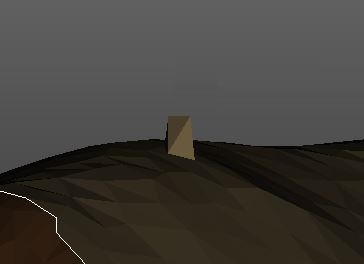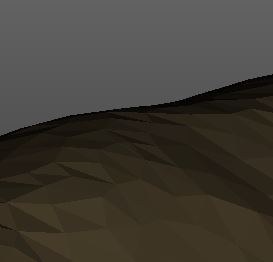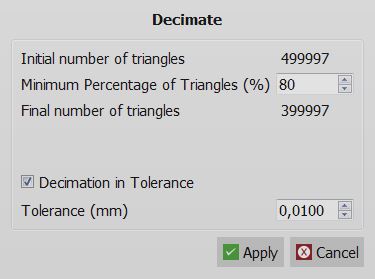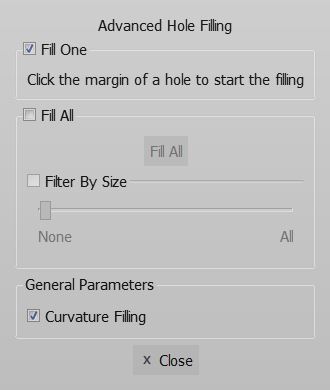Difference between revisions of "Man MeshEditing"
| Line 5: | Line 5: | ||
<!--T:2--> | <!--T:2--> | ||
| − | When generating a mesh starting from data acquired by a scanner the meshes may not be perfect for | + | When generating a mesh starting from data acquired by a scanner the meshes may not be perfect for the designated use. |
<!--T:39--> | <!--T:39--> | ||
| − | The generated mesh may have artifacts, | + | The generated mesh may have artifacts, noises or holes that need to be fixed. |
<!--T:40--> | <!--T:40--> | ||
| − | OpticalRevEng Dental already | + | OpticalRevEng Dental already applies a different mesh generation strategy specific to each element, trying to fix all the problems automatically, however there could be the need to further edit the meshes before exporting them to another software. |
<!--T:41--> | <!--T:41--> | ||
| − | In this page | + | In this page are described the Mesh Editing tools provided that can be found in the [[Support_Toolbars_And_Menus|Mesh Menu and Mesh Toolbar]]. |
== Remove Spikes == <!--T:3--> | == Remove Spikes == <!--T:3--> | ||
<!--T:4--> | <!--T:4--> | ||
| − | A '''spike''' in a mesh is | + | A '''spike''' in a mesh is defined as a tiny part of the surface that is not actually part of the 3D object Acquired by the scanner. |
<!--T:42--> | <!--T:42--> | ||
| − | + | These spikes are normally automatically corrected by the software during mesh generation, but if meshes are imported from other system there could be some of them. | |
<!--T:43--> | <!--T:43--> | ||
| − | This | + | This tool automatically removes all the found spikes and repair the mesh. |
<!--T:5--> | <!--T:5--> | ||
| Line 33: | Line 33: | ||
<!--T:7--> | <!--T:7--> | ||
| − | The sharpening | + | The sharpening tool performs two actions at the same time. It smooths the parts of the surface that are more planar and it sharpens the edges. It takes 2 parameters: |
<!--T:44--> | <!--T:44--> | ||
| − | # T [°] : This angle | + | # T [°] : This angle identifies what an edge is, all the parts of the surface that create an angle minor than T° will be sharpened. When this value is at 0 all the surface will be smoothed |
| − | # Normal Iterations : How many times the software will pass over the surface to do the sharpening. Bigger values | + | # Normal Iterations : How many times the software will pass over the surface to do the sharpening. Bigger values mean more smmoting and more sharpening |
<!--T:45--> | <!--T:45--> | ||
| − | ''' | + | '''The software already applies this tool automatically using specific parameters. The use of this tool applying wrong parameters may modify the shape and dimension of the objects'''. |
== Mesh Smooth == <!--T:8--> | == Mesh Smooth == <!--T:8--> | ||
<!--T:9--> | <!--T:9--> | ||
| − | This tool is similar to the Mesh Sharpening | + | This tool is similar to the Mesh Sharpening tool but it applies a smoothing to the whole surface without preserving the edges. |
<!--T:46--> | <!--T:46--> | ||
| − | ''' | + | '''The software already applies this tool automatically using specific parameters. he use of this tool applying wrong parameters may modify the shape and dimension of the objects'''. |
== Mesh Decimate == <!--T:10--> | == Mesh Decimate == <!--T:10--> | ||
<!--T:11--> | <!--T:11--> | ||
| − | This tool will try to reduce the number of | + | This tool will try to reduce the number of triangles in a mesh, to save more space, trying to save as much detail as possible. |
<!--T:47--> | <!--T:47--> | ||
| Line 59: | Line 59: | ||
<!--T:12--> | <!--T:12--> | ||
| − | On the top | + | On the top is specified the current number of triangles of the selected meshes. |
<!--T:48--> | <!--T:48--> | ||
| − | + | It is possible to input a percentage of triangles to be kept (For example 50% to halve the mesh size). | |
<!--T:49--> | <!--T:49--> | ||
| − | + | It is also possible to establish a tolerance value. If the tolerance is enabled the software will stop the decimation if this will modify the mesh more than the tolerance parameter. | |
<!--T:50--> | <!--T:50--> | ||
| − | + | Just click on Apply to see the result. | |
== Mesh Defeature == <!--T:13--> | == Mesh Defeature == <!--T:13--> | ||
<!--T:14--> | <!--T:14--> | ||
| − | This tool | + | This tool takes a selection of the mesh and it removes all the details, leaving the simpliest surface possible. It removes holes, spikes, noises. To use this tool: |
<!--T:51--> | <!--T:51--> | ||
| − | # Select the area | + | # Select the area in which it is necessary to remove all the ''Features'' with the [[Man_DataEditing#Selection_Tools|Selection Tools]] |
# Apply the ''Mesh Defeature'' | # Apply the ''Mesh Defeature'' | ||
| Line 82: | Line 82: | ||
<!--T:16--> | <!--T:16--> | ||
| − | This tool | + | This tool takes a mesh and searches for and removes the parts of the surface that are not ''Manifold'' as this [https://en.wikipedia.org/wiki/Manifold definition] |
== Mesh Catenate == <!--T:17--> | == Mesh Catenate == <!--T:17--> | ||
<!--T:18--> | <!--T:18--> | ||
| − | This tool can be used only in [[Free_Mode|Free Mode]]. It takes all the | + | This tool can be used only in [[Free_Mode|Free Mode]]. It takes all the selected meshed and creates a single mesh merging all of the selected meshes togheter. |
== Flip Normals == <!--T:19--> | == Flip Normals == <!--T:19--> | ||
<!--T:20--> | <!--T:20--> | ||
| − | Every mesh has an inside and an outside. | + | Every mesh has an inside and an outside. They are distingushed by the software by appliying a different color to the inside of the image. This tool flips the inside and the outside of the selected meshes. |
== Detect Intersections == <!--T:21--> | == Detect Intersections == <!--T:21--> | ||
<!--T:22--> | <!--T:22--> | ||
| − | Sometimes is possible that part of the surface of a mesh intersect with the mesh itself, something that in reality is not possibile. This tool | + | Sometimes it is possible that part of the surface of a mesh intersect with the mesh itself, something that in reality is not possibile. This tool identifies this situations and fixes them |
== Fill All Holes == <!--T:23--> | == Fill All Holes == <!--T:23--> | ||
<!--T:24--> | <!--T:24--> | ||
| − | This is an interactive tool that | + | This is an interactive tool that allows to fill holes in the currently selected mesh. |
<!--T:52--> | <!--T:52--> | ||
| Line 113: | Line 113: | ||
<!--T:26--> | <!--T:26--> | ||
| − | In the fill one mode the software will highlight the hole near the mouse cursor, and | + | In the fill one mode the software will highlight the hole near the mouse cursor, and by clicking with the left mouse button on the highlighted hole the sofware will close it. |
=== Fill All === <!--T:27--> | === Fill All === <!--T:27--> | ||
<!--T:28--> | <!--T:28--> | ||
| − | In the fill all | + | In the fill all mode the software will try to close all the holes. With the ''Filter By Size'' function it is possible to select all the holes below one size and close only those. The selected holes will be highlighted in real time by the sofware. |
=== Curvature Filling === <!--T:29--> | === Curvature Filling === <!--T:29--> | ||
<!--T:30--> | <!--T:30--> | ||
| − | There is an additional option | + | There is an additional option: curvature filling. If this option is enabled the software will try to follow the curvature of the rest of the surface closing the hole. If it's disabled the software will ignore the rest of the surface and close the hole with a straight plane. |
== Close Denturse == <!--T:31--> | == Close Denturse == <!--T:31--> | ||
<!--T:32--> | <!--T:32--> | ||
| − | When | + | When scanning an entire jaw there will be a big hole at the base. This tool is made to close only that hole. Closing that hole with the Fill All Holes tool take a lot of time and the final result will not be good enough. |
<!--T:54--> | <!--T:54--> | ||
| − | With the close denturse tool the mesh will be closed with a perfect plane | + | With the close denturse tool the mesh will be closed with a perfect plane in a reduced amount of time. |
<!--T:55--> | <!--T:55--> | ||
| Line 139: | Line 139: | ||
<!--T:34--> | <!--T:34--> | ||
| − | This tool | + | This tool takes a mesh and tries to remove all the possible artifacts and problems. |
== Mesh Offset == <!--T:35--> | == Mesh Offset == <!--T:35--> | ||
<!--T:36--> | <!--T:36--> | ||
| − | This tool | + | This tool creates a bigger/smaller version of the selected mesh. You can select how to change the mesh with the Offset [mm] parameter. |
<!--T:56--> | <!--T:56--> | ||
| − | The three flags (Remesh, Sharpen and Optimize Vertices) | + | The three flags (Remesh, Sharpen and Optimize Vertices) have to remain checked. |
<!--T:37--> | <!--T:37--> | ||
| − | Normally none of | + | Normally none of these tools is needed to work because the strategies already apply a selected sequence of these tools specific for every element. |
=Next= <!--T:38--> | =Next= <!--T:38--> | ||
Revision as of 14:33, 21 August 2015
Contents
Mesh Editing
When generating a mesh starting from data acquired by a scanner the meshes may not be perfect for the designated use.
The generated mesh may have artifacts, noises or holes that need to be fixed.
OpticalRevEng Dental already applies a different mesh generation strategy specific to each element, trying to fix all the problems automatically, however there could be the need to further edit the meshes before exporting them to another software.
In this page are described the Mesh Editing tools provided that can be found in the Mesh Menu and Mesh Toolbar.
Remove Spikes
A spike in a mesh is defined as a tiny part of the surface that is not actually part of the 3D object Acquired by the scanner.
These spikes are normally automatically corrected by the software during mesh generation, but if meshes are imported from other system there could be some of them.
This tool automatically removes all the found spikes and repair the mesh.
Mesh Sharpening
The sharpening tool performs two actions at the same time. It smooths the parts of the surface that are more planar and it sharpens the edges. It takes 2 parameters:
- T [°] : This angle identifies what an edge is, all the parts of the surface that create an angle minor than T° will be sharpened. When this value is at 0 all the surface will be smoothed
- Normal Iterations : How many times the software will pass over the surface to do the sharpening. Bigger values mean more smmoting and more sharpening
The software already applies this tool automatically using specific parameters. The use of this tool applying wrong parameters may modify the shape and dimension of the objects.
Mesh Smooth
This tool is similar to the Mesh Sharpening tool but it applies a smoothing to the whole surface without preserving the edges.
The software already applies this tool automatically using specific parameters. he use of this tool applying wrong parameters may modify the shape and dimension of the objects.
Mesh Decimate
This tool will try to reduce the number of triangles in a mesh, to save more space, trying to save as much detail as possible.
On the top is specified the current number of triangles of the selected meshes.
It is possible to input a percentage of triangles to be kept (For example 50% to halve the mesh size).
It is also possible to establish a tolerance value. If the tolerance is enabled the software will stop the decimation if this will modify the mesh more than the tolerance parameter.
Just click on Apply to see the result.
Mesh Defeature
This tool takes a selection of the mesh and it removes all the details, leaving the simpliest surface possible. It removes holes, spikes, noises. To use this tool:
- Select the area in which it is necessary to remove all the Features with the Selection Tools
- Apply the Mesh Defeature
Make Manifold
This tool takes a mesh and searches for and removes the parts of the surface that are not Manifold as this definition
Mesh Catenate
This tool can be used only in Free Mode. It takes all the selected meshed and creates a single mesh merging all of the selected meshes togheter.
Flip Normals
Every mesh has an inside and an outside. They are distingushed by the software by appliying a different color to the inside of the image. This tool flips the inside and the outside of the selected meshes.
Detect Intersections
Sometimes it is possible that part of the surface of a mesh intersect with the mesh itself, something that in reality is not possibile. This tool identifies this situations and fixes them
Fill All Holes
This is an interactive tool that allows to fill holes in the currently selected mesh.
This tool can work in 2 different ways
Fill One
In the fill one mode the software will highlight the hole near the mouse cursor, and by clicking with the left mouse button on the highlighted hole the sofware will close it.
Fill All
In the fill all mode the software will try to close all the holes. With the Filter By Size function it is possible to select all the holes below one size and close only those. The selected holes will be highlighted in real time by the sofware.
Curvature Filling
There is an additional option: curvature filling. If this option is enabled the software will try to follow the curvature of the rest of the surface closing the hole. If it's disabled the software will ignore the rest of the surface and close the hole with a straight plane.
Close Denturse
When scanning an entire jaw there will be a big hole at the base. This tool is made to close only that hole. Closing that hole with the Fill All Holes tool take a lot of time and the final result will not be good enough.
With the close denturse tool the mesh will be closed with a perfect plane in a reduced amount of time.
This tool will not work if the mesh has other holes or artifacts.
Mesh Cleaning
This tool takes a mesh and tries to remove all the possible artifacts and problems.
Mesh Offset
This tool creates a bigger/smaller version of the selected mesh. You can select how to change the mesh with the Offset [mm] parameter.
The three flags (Remesh, Sharpen and Optimize Vertices) have to remain checked.
Normally none of these tools is needed to work because the strategies already apply a selected sequence of these tools specific for every element.
Next
You can now return to the Main Page or continue to the Implant Align page.



